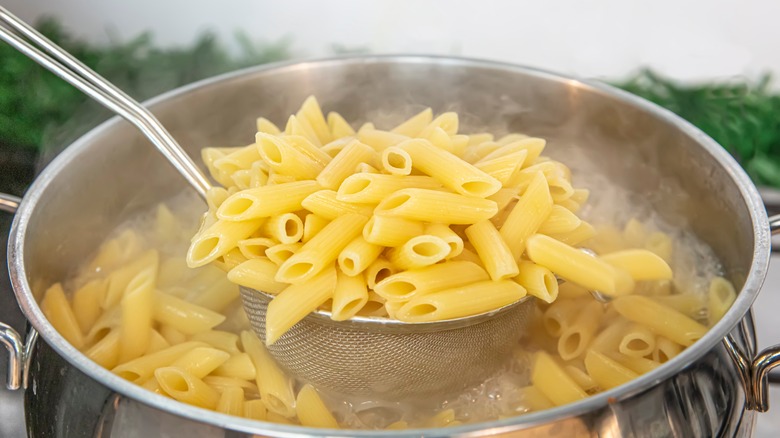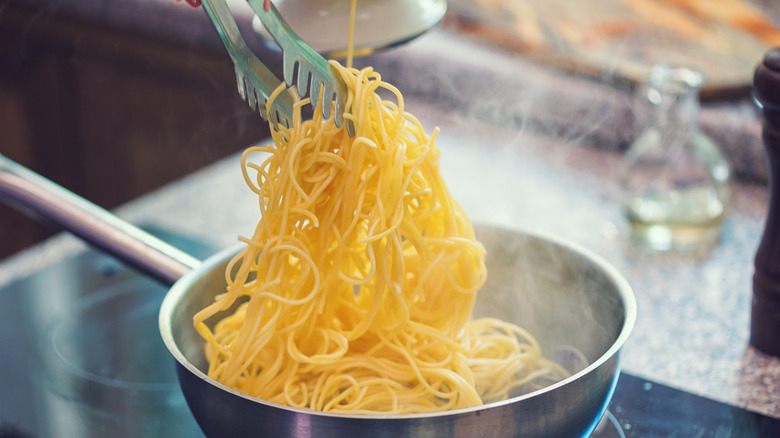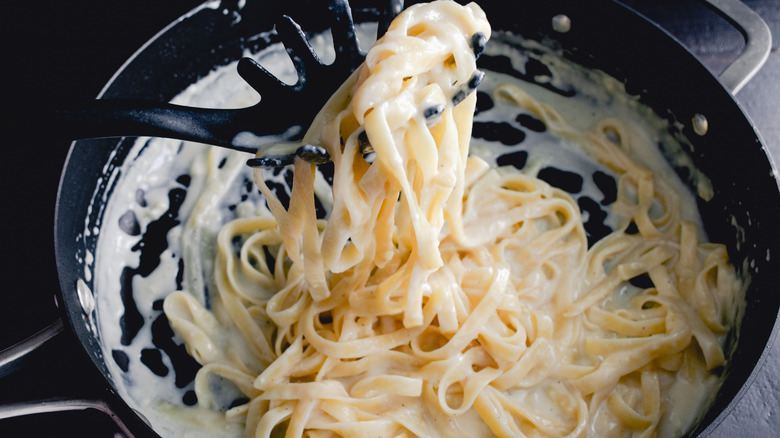Sauteing Overcooked Pasta Is One Of The Simplest Ways To Revive It
There are two types of people in this world: those who cook pasta with a timer, and those who cook pasta by watching the boiling pot and periodically checking pieces to see if they're al dente. Unfortunately, while cooking without a timer seems a little more romantic, it's pretty easy to walk away and forget the pasta bubbling away on the stove for a few minutes and end up with overcooked penne. You don't have to start dinner all over again, however; if you accidentally cook your pasta too much, you just have to get out a sauté pan and do a little damage control.
If you've overcooked your pasta by just a few minutes, drain the pasta soon as possible, and get a skillet hot on the stove. While you can't go back in time and un-boil your pasta, you can sauté it in a bit of oil or butter. The dry heat in the pan will crisp up the edges of your soggy noodles, which will somewhat save the day. If you really want to cover your tracks, once you've crisped up your pasta, you can add some extra ingredients to the pan and nobody will be the wiser.
Saved by sauteéing
If you find yourself with a slightly soft batch of spaghetti, the first thing you need to do is to stop the cooking process so that it doesn't get any soggier. Drain your pasta into a colander or strainer and run cool water over it to stop the cooking process. Now, heat up some cooking oil or butter in a flat-bottomed sauté pan or skillet that can hold the volume of your pasta without spilling over the sides. If you have a large amount of pasta you might need to work in batches, because the pieces of pasta need contact with the hot bottom of the pan to get crisp.
Once you have your pan warmed up, place your mushy macaroni in the pan and move it around until some of the surfaces start to brown. The hot pan will evaporate the surface of the pasta and create a maillard reaction, which is what makes food brown when exposed to heat. Not only will the outside of your pasta get a little bit more texture, you're also adding a little bit of flavor, the same way you would when browning a piece of toast. Don't go too far, though; just let things sizzle around for four or five minutes until there's some light browning here and there, and then taste it to see if it's firm enough.
Add other ingredients
The sauté pan technique won't completely fix your pasta problem, but it should get you at least in a good position to rethink your dinner a little bit. Plus, since you already have the pan on the stove you can throw in some other crunchy ingredients that will take the focus off your pasta's texture, like broccoli, snow peas, and carrots. Alternatively, you can lean into the softness and add a rich sauce, like alfredo.
If you've wildly overcooked your pasta, however, you're probably out of luck if you were hoping for the perfect bed for a bolognese. You can still save your starch by baking it in a frittata for tomorrow's breakfast (or lunch), or make some layers of pasta, tomato sauce, ricotta, and mozzarella for a lasagna-like pasta bake.
If you really think your noodles are too far gone, and the sauté pan isn't doing the trick, there's no shame in starting over again if you're really craving that macaroni and cheese. Just try to compost it if you're going to throw the pasta away. When you start over this time, however, don't leave things to chance — definitely set a timer!


